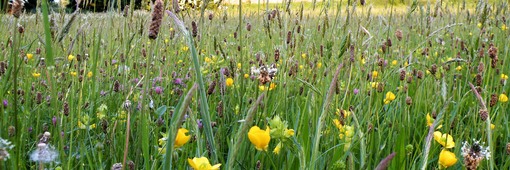

Biodiversity
Action
Plan
Key features of Neutral Grassland for wildlife species
Neutral Grassland is found on shale soils or alluvial deposits in Barnsley. Sustaining an ‘unimproved nature’ is important for a range of plants which cannot tolerate competition from more vigorous grass species associated with agriculturally improved grasslands.
Managing sites by wide scale frequent mowing or intensive periods of grazing will be unsuitable for many species.
Species supported by grassland
Birds. Neutral Grassland supports birds such as Lapwing, Grey Partridge, Skylark, Yellow Hammer, Linnet and other finches, as well as Starling, Kestrel and Barn owl.
Mammals. Voles, mice, shrews, Brown Hare, Hedgehog, Mole
Reptiles/Amphibians Grass Snake, newts
Invertebrates. A wide range of invertebrates including solitary bees and wasps, bumblebees, butterflies, moths, and grasshoppers.
Butterflies include Meadow Brown, Ringlet, Common Blue, Small Heath. Moths include Chimney Sweeper feeding on Pignut
Plants
Neutral grassland can have a rich array of flowering plants: Common Knapweed, Great Burnet, Ox-Eye Daisy, Hawkbits, Cat’s Ear, Dandelion, Meadow Buttercup, Pignut, SelfHeal, Lady’s bedstraw, Red Clover, Birds Foot Trefoil, vetches and Yellow Rattle. Adder’s Tongue Fern, Ribwort plaintain, and Common Sorrel..
A rich variety of grasses can be found in Neutral Grassland including: Sweet Vernal Grass, Crested Dog’s-Tail, Red Fescue, Common Bent, and Yorkshire Fog with occasional Quaking Grass, Smooth Meadow-Grass, Yellow Oat-Grass and Cat’s Tail.
Flower-rich neutral grassland at Pye Flatts Meadows. Image Brian Parkinson
The presence of flowers for nectar and pollen, and plants for food and shelter throughout the spring and summer, are critical to a number of invertebrate and other species, some of which are dependent on specific plant species at times of their life cycle.
Different species require widely different types of grass length - sward structure - and no single type is beneficial for all.
Longer swards with copious invertebrates and seeds support a more numerous and varied small mammal and bird population, including sparrows and finches, feeding on them.
Open and short swards, often only a few centimetres high, are favoured by birds like Lapwing, Starling and thrushes and mammals such as Hedgehog, feeding on soil invertebrates.
Adjacent areas such as hedgerows, scrub and woodland support species requiring places to nest and roost as well as feed, such as Yellow Hammer.
The main features of good quality neutral grassland priority habitat are
- A species-rich sward of flowering plants and fine grasses
- A high proportion of cover of wildflowers and sedges
- A low amount of rye grasses and white clover.
The best form of management is ‘cut and remove’ in late summer – preferably as a hay crop. This maintains a lower level of fertility that benefits herb species. Cut and leave would encourage more grass growth after the mulch rots down releasing nutrients. Mulching also suppresses more delicate herb species and encourages nettles to take over.
Grazing after cutting in autumn and very early spring encourages plant diversity in meadows by preventing the take-over by bigger species such as Cocks Foot, False Oats, Hogweed, Dock and Cow Parsley


Neutral Grassland Features
BAP Priority Neutral Grassland [Lowland Meadows] characteristics:
At least two of:
- A high cover of wildflowers and sedges (30% or more) excluding white clover, creeping buttercup and injurious weeds
- A species-rich sward of flowering plants and grasses, ≥15 species /m2
- A low cover of rye grasses and white clover(less than 10%)
Assessing BAP Habitat Lowland Meadow
Moderately species-rich neutral grassland: two of 9-15 species/m2, ≥20% wildflower and sedges cover, and <30% rye grasses and white clover is classed as Semi-Improved Grassland. Assessing grassland: Semi-improved grassland
From Natural England Assessing Priority Habitat TIN110. See also Magnificent Meadows How to identify different types of grassland, based on the same publication.